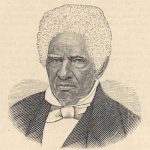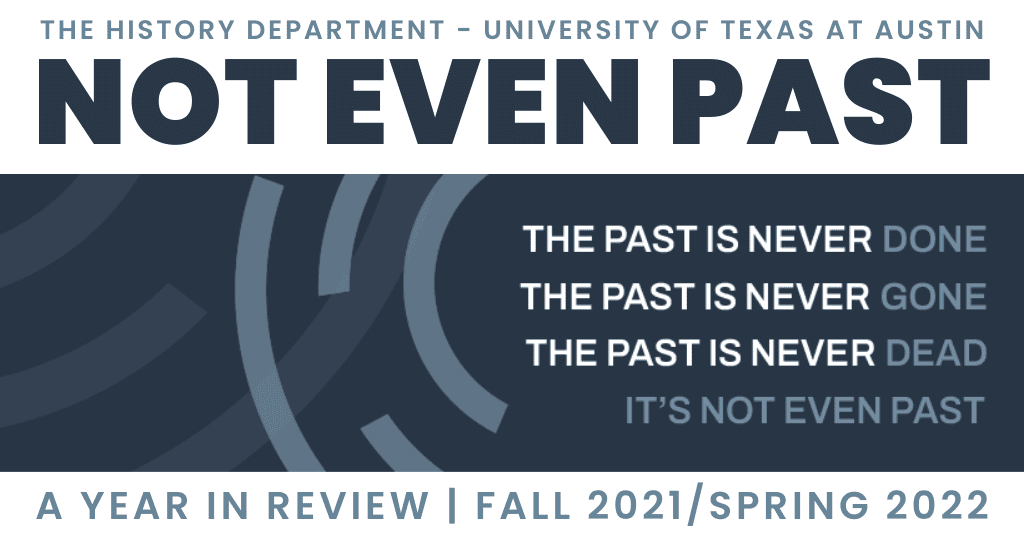
It’s been another busy year for Not Even Past with more than 130 articles published across the academic year. To celebrate all this incredible academic content we have compiled everything in one page below. Not Even Past‘s reach also continues to grow, and we just broke a million page views over the past 12 months, making the magazine an important resource not just for the University of Texas community but for Public History online.
NEP Year in Review 2021-22 by Adam ClulowTo view specific sections, use the links below:
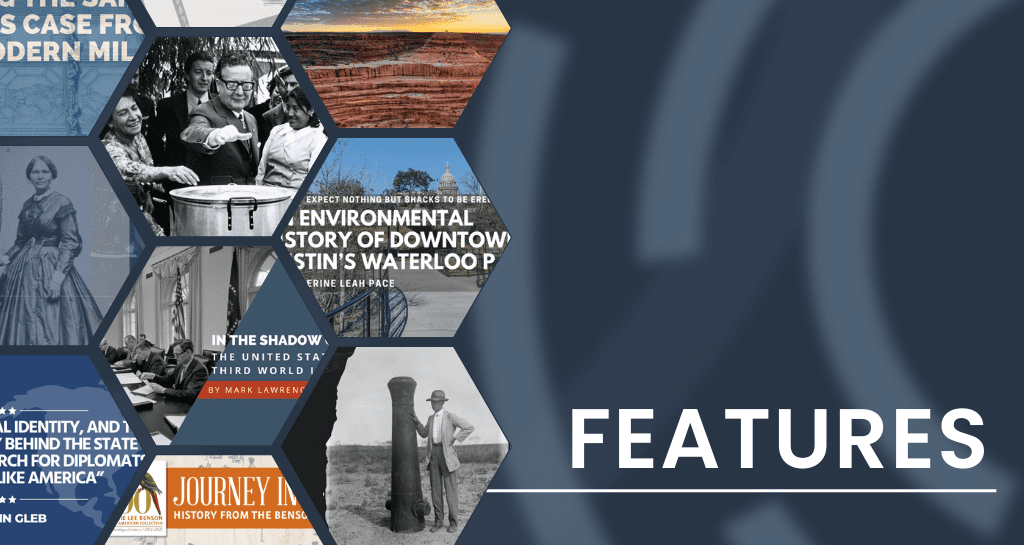
Features
- Bears Ears National Monument by Jesse Ritner
- Learning from U.S History: A Fifth Grade Social Studies Curriculum by Dr. Daina Ramey Berry and Dr. Jennifer Keys Adair
- Unboxing the Saints: A Curious Case from Early Modern Milan by Dr. Madeline McMahon
- Tasting Empanadas and Red Wine in Chile’s Popular Unity Revolution by Dr. Joshua Frens-String
- Journey into the Archive: The McFarland Cuban Plantation Records by Katie Coldiron
- Primary Source: Notes for a Napoleonic Scandal by Julia Stryker
- Journey into the Archive: Bringing Together the Relaciones Geográficas and Topográficas of the Spanish Empire by Rafael Nieto-Bello
My life’s story has come to be entwined with the history of the Relaciones. My intellectual place of origin, Bogotá, Colombia, facilitated my first encounter with them. My continued engagement with these sources from Latin American classrooms and special collections to Spanish archives has culminated in my current dissertation project at the University of Texas at Austin – the principal observatory and repository of these documents in the Americas. My life and research paths have allowed me to explore this neglected historical terrain. I argue that by drawing together the Relaciones Geográficas and Topográficas as a genre of documents, we can better envision how people from diverse ethnic compositions on both sides of the Atlantic produced a massive number of descriptions of local nature and societies around the same period. This perspective may allow us to see and understand the complex knowledge networks of Atlantic towns that the Spanish Crown wove together. Consider, for instance, how the Relaciones go beyond the famous Mexican indigenous charts as revealed by Map 2, the Relación of Valledupar, a township located in what is now Colombia.
Rafael Nieto-Bello
- Hidden in Plain Sight: Re-Viewing Juan de Miranda’s Portrait of Sor Juana Inés de la Cruz by Dr. Susan Deans-Smith and Dr. John W. Smith
- Hidden in Plain (Virtual) Sight: Searching for a Lost Portrait of Sor Juana by Juan de Miranda and Finding a Photograph of it in a Digital Archive by Dr. Susan Deans-Smith and Dr. John W. Smith
- In the Shadow of Vietnam: The United States and the Third World in the 1960s by Dr. Mark Atwood Lawrence
- Archives and their Afterlives: Conversing with the Work of Kirsten Weld by Ilan Palacios Avineri
- Flash of Light, Wall of Fire by Ben Wright
- The Man Who Sold the Border: The Mercantile Imagination of Robert Runyon by Dr. Annette M. Rodríguez
Robert Runyon was an astoundingly prolific photographer of the Texas-México borderlands at the turn of the twentieth century. The University of Texas at Austin hosts over 14,000 photographs donated by the Runyon family, along with related manuscript materials. Much of the collection is available digitally, and the Briscoe Center for American History also houses Runyon’s glass negatives, lantern slides, nitrate negatives, prints, postcards, panoramas, correspondence, and business records. The sheer scope of his work, which ranges from botanicals to portraiture to quotidian scenes of daily life, has rendered his imagery—in regard to Texas and the U.S.-México border—ubiquitous.
Annette M. Rodríguez
- The Archive as Nepantla: Dr. Daniel Arbino, The Anzaldúa Papers and The Intricacies of Being Beyond Doing by Ana López H.
- Adriana Pacheco Roldán and Community Building by Ashley Garcia
- Primary Source: The Pirate Zheng Yi Sao and a Fine Press Publisher by Jacob Parr
- A House in the Homeland: Armenian Pilgrimages to Places of Ancestral Memory by Carel Bertram
- “We may expect nothing but shacks to be erected here”: An Environmental History of Downtown Austin’s Waterloo Park by Dr. Katherine Leah Pace
The largest green space in downtown Austin, Waterloo Park takes its name from the Waterloo hamlet, a frontier settlement that Austin replaced. It sits in a basin along Waller Creek, encompassing a particularly flood-prone stretch of Austin’s most central, urbanized stream. Though the park was built in 1975 as part of the Brackenridge Urban Renewal Project, its history dates to the end of the US Civil War, when formerly enslaved people began migrating to southern cities in search of work, education, lost family members, and haven from anti-Black violence. Many migrants were skilled farmers and craftsmen and had saved money to purchase land. As a rule, white landowners sold Black people only their “poorest” properties, relegating most Black communities to low-lying and otherwise hazardous spaces.
Katherine Leah Pace
- Diversity, National Identity, and the Fraught History Behind the State Department’s Search for Diplomats Who “Look Like America” by John Gleb
- Mary Todd Lincoln, Elizabeth Keckley, and the Queer History of the Old Clothes Scandal by Candice Lyons
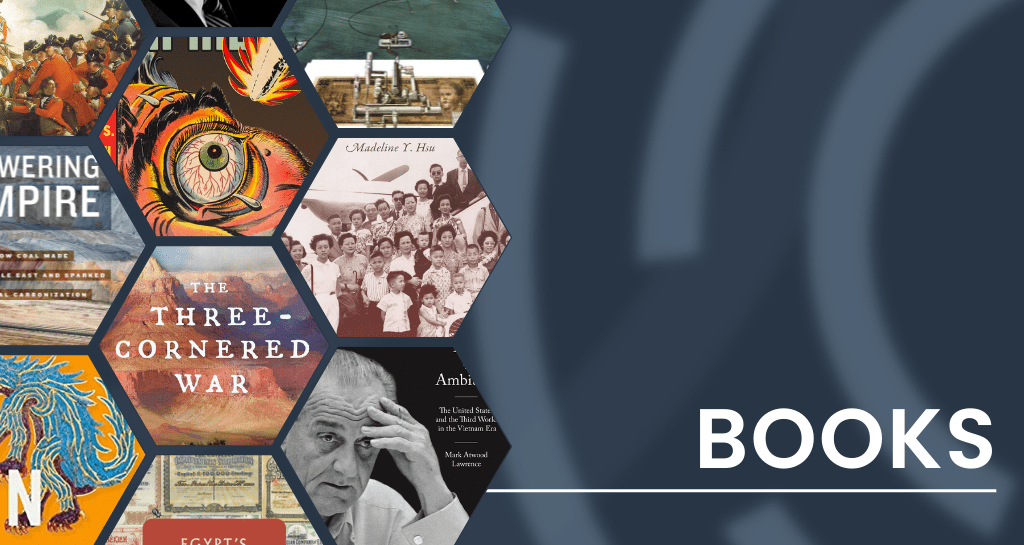
Books
- Fifth Sun: A New History of the Aztecs by Camilla Townsend (2019), reviewed by Camila Ordorica
- Cotton, Coal, and Capitalism: Review of Aaron Jakes’ Egypt’s Occupation and On Barak’s Powering Empire reviewed by Atar David
- The Fishmeal Revolution: The Industrialization of the Humboldt Current Ecosystem by Kristin A. Wintersteen (2021), reviewed by Nathan Stone
I remember the stink of the fishmeal plants in Iquique. During the austral winter of 1983, the vapors that turned tons of whole anchoveta into high protein fish flour lingered over the beach with the coastal fog until the customary afternoon breeze came and carried it away. Local residents called it “the smell of money.” Domestically produced fish flour had become the primary source for fish food in the new salmon farms that had begun to scar the pristine beauty of the lakes and fiords in the Chilean south. It would also become dog food, and the “high protein cookies” on school lunch menus for the undernourished children that General Pinochet’s second recession in ten years had pushed dangerously down the path of deficiency disease. But the smelly fishmeal extracted from the seemingly infinite Pacific coast of northern Chile had already become a vital element in an increasingly global ecosystem of profit-driven food production. Economists and technocrats called it a “non-traditional export.” Along with the farmed salmon, the fresh fruit out of season and the world’s finest red wines for a little less money, Chilean fishmeal would help reduce the local economy’s absolute dependence on the roller coaster of international copper prices. It would fatten pigs in Germany and chickens in California to satisfy the voracious appetites of a competing species now referred to simply as “the consumer.”
Nathan Stone
- The Optic of the State: Visuality and Power in Argentina and Brazil (2007), reviewed by Rodrigo Salido Moulinié
- The Good Immigrants: How the Yellow Peril Became the Model Minority (2015), reviewed by Christopher Ndubuizu
- The Three-Cornered War: The Union, the Confederacy, and Native Peoples in the Fight for the West by Megan Kate Nelson (2020), reviewed by Gwendolyn Lockman
Megan Kate Nelson has written a captivating history of the southwestern theater of the American Civil War. There more than one war took place as different groups of people envisioned futures dependent on control of the region. The balance of perspectives makes it clear the Civil War was not just a battle for the preservation of the Union, or for those states that had seceded, but rather a multicultural war for control of much of the North American continent. The Union, the Confederacy, Mexico, the Apache, and Navajo (Diné) all fought for control of land, water, resources, and trade. Skirmishes in the West were layered contests among several parties. While historians often acknowledge the importance of the West in determining the fate of slavery in an expanding nineteenth-century United States, few have tackled the southwestern theater as Nelson has in The Three Cornered War.
Gwendolyn Lockman
- Subjected to Science: Human Experimentation in America before the Second World War by Susan Lederer (1995), reviewed by Juliana Márquez
- Undocumented Lives: The Untold Story of Mexican Migration (2018), reviewed by Jian Gao
- Hungry for Revolution: The Politics of Food and the Making of Modern Chile (2021), reviewed by Gabrielle Esparza
- The Approaching Storm: Roosevelt, Wilson, Addams, and their Clash over America’s Future (2021), reviewed by John Gleb
- The End of Ambition: The United States and the Third World in the Vietnam Era (2022), reviewed by Bryan Port
- Pulp Empire: The Secret History of Comic Book Imperialism (2021), reviewed by Jon Buchleiter
Pulp Empire is filled with fascinating anecdotes and incisive analysis of the ephemera of US empire. This book offers something for an array of audiences from fervent comic book fans to historians of American foreign policy. Hirsch deftly deals with several dimensions of comics’ hidden history from their perpetuation of racist and sexist tropes to their use as a unique tool of soft-power popular abroad across class lines. Finally, Hirsch’s analysis of the debates over the atomic age played out in comic book pages proves both entertaining and enlightening. Pulp Empire effectively interrogates the intersection between politics and popular culture and profiles how superheroes have been deployed to serve American expansionist goals.
Jon Buchleiter
- The Dawn of Everything: A New History of Humanity by David Graeber and David Wengrow (2021), reviewed by Dr. Sumit Guha
- The Men Who Lost America: British Command during the Revolutionary War and the Preservation of the Empire (2013), reviewed by Ben Wright
- Sex Among the Rabble: An Intimate History of Gender and Power in the Age of Revolution, Philadelphia, 1730-1830 (2006), reviewed by Jon Buchleiter
- The Butterfly Effect: Insects and the Making of the Modern World (2020), reviewed by Atar David
- Master of the Game: Henry Kissinger and the Art of Middle East Diplomacy (2021), reviewed by Daniel J. Samet

Teaching
- Documenting Austin Activism, 1965-82 by Dr. Laurie Green
- Teaching Global Environmental History: A Conversation with Dr. Megan Raby
- Austin’s Queer Migration History by Dr. Lauren Gutterman
In Spring 2021, my course, “Preserving Austin’s Queer History,” trained undergraduate students to conduct oral history interviews with LGBTQ community members past and present. Despite the challenges of the COVID-19 pandemic and the February 2021 weather disaster, the fifteen students in this class conducted oral history interviews with nineteen people. These oral history narrators range in age from thirty-four to eighty-four years old. They include gay, lesbian, bisexual, queer, trans and non-binary people, as well as artists and performers, grassroots activists, and small business owners. They are white, Black, Latinx, Asian American, and multi-racial. And they have contributed to Austin’s LGBTQ history and to local struggles against injustice in a variety of ways.
Lauren Gutterman
- Resources For Teaching Black History: Collected Works on Not Even Past, compiled by Alina Scott and Gabrielle Esparza
- Art and the Public by Dr. Joan Neuberger
- Resources for Teaching Women’s History: Collected Works on Not Even Past, compiled by Gabrielle Esparza
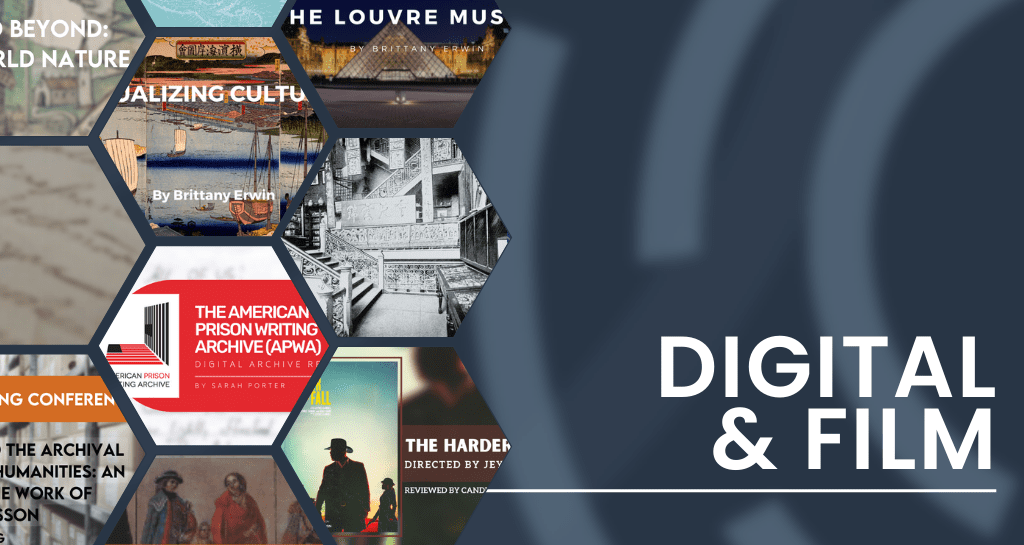
Digital and Film
- The Louvre Museum by Brittany Erwin
- The American Prison Writing Archive (APWA) by Sarah Porter
- Visualizing Cultures by Brittany Erwin
- The Harder They Fall, Directed by Jeymes Samuel, reviewed by Candice Lyons
In one of the final scenes of Jeymes Samuel’s gripping 2021 Black Western The Harder They Fall, androgynous outlaw Cuffee (played by Danielle Deadwyler) says a teary goodbye to her comrade “Stagecoach” Mary Fields (Zazie Beetz). The two share a long, not-quite-chaste kiss goodbye as Nat Love, Mary’s main romantic interest in the film, shifts uncomfortably in his saddle. Mary responds with a coy “What you looking at?” before mounting her horse a final time and literally riding off into the sunset with Love, leaving Cuffee behind. The film, which follows Nat Love and his gang of outlaws on an epic revenge quest across the American southwest, encompasses a litany of historical elisions and inaccuracies, culminating in this moment between Mary and Cuffee. It cements the movie’s final and most glaring lapse: while The Harder They Fall’s vision of the Old West is brazen, bold, and Black, its queer notes amount to little more than whispers. Not only was the real “Stagecoach” Mary Fields (as several writers have noted) much taller, darker, and heavier than she is depicted in the film, she was probably much queerer as well.
Candice Lyons
- Unlocking the Colonial Archive: Revolutionizing Latin American History with Artificial Intelligence by Eduardo H. Gorobets Martins
- The Intra-American Slave Trade Database: A Review and Interview with Gregory O’Malley and Alex Borucki by Clifton Sorrell III
- The University of Pennsylvania Museum of Archaeology and Anthropology by Brittany Erwin
- Radical Collaboration: Brook Lillehaugen and the Ticha Project by May Helena Plumb
A key thread running through Dr. Brook Danielle Lillehaugen’s career is access—to language, to history, and to education. She recognizes that linguistic research on Indigenous languages is insufficient if members of Indigenous communities cannot access it. Therefore, throughout her career she has sought to remove barriers to such access via creative, collaborative research that goes beyond traditional academic practice.
May Helena Plumb
- Counter Archives and Archives of Resistance by Anahí Ponce
- Coding Viceregal Art: Project Arca and Spanish Visual Culture Within the Digital Humanities by Haley Schroer
Throughout the last two years of the global pandemic, digital research has surged among graduate students and faculty alike. Travel restrictions prevented scholars from accessing important sources. Project Arte Colonial and the continuing efforts of Jaime H. Borja Gómez have provided invaluable access to colonial Spanish resources to individuals across the world who are unable to conduct research in-person. The digital humanities have become critical components to fields across the social sciences. ARCA works to create an easily accessible gateway that simultaneously serves veterans and newcomers of remote research. Historians must adopt new and diverse ways to engage with the public and other scholars through the medium of technology.
Haley Schroer
- The Public, Access, and the Archival Dimensions of Digital Humanities: An Introduction to the Work of Christina Wasson by Eden Ewing
- The New World and Beyond: A Review of New World Nature by Shery Chanis
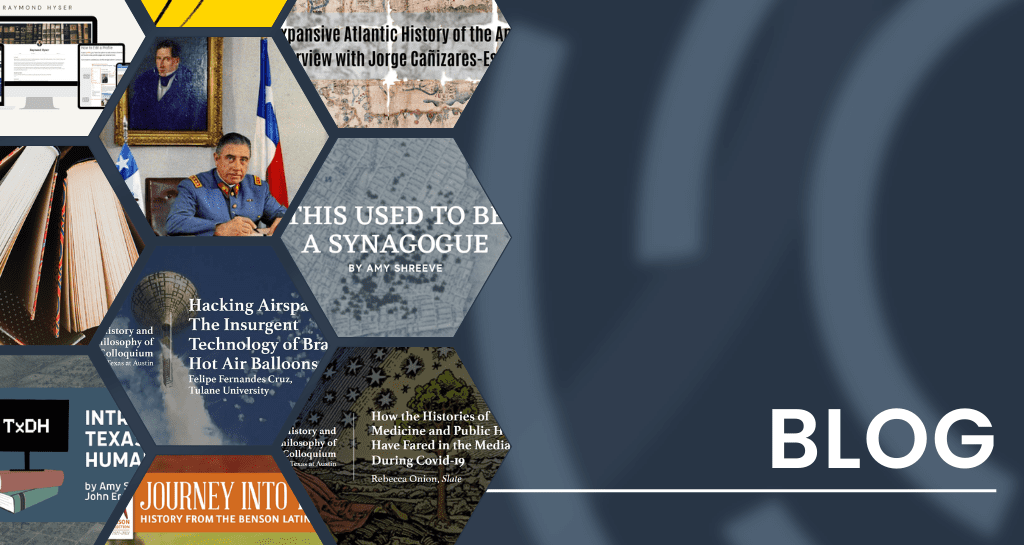
Blog
- Forward-Looking Perspectives upon Returning to the Classroom and the Zoomroom by Gwendolyn Lockman
- Conversations with Dr. Miruna Achim by Camila Ordorica
- Humanities Without Walls: A Reflection by Brandon James Render
- From Huehuetenango to Here by Ilan Palacios Avineri
My Guatemalan father was born in the middle of a civil war. His childhood house was built from corrugated metal and adobe brick. He grew up clinging to my abuela’s back wrapped in a blanket as she weaved to sustain the family. He did not have shoes until he was 8 years old. He dropped out of school after the second grade. Before he reached my age, he was nearly murdered by the army three times. He worked as a trench digger and then as a laborer before fleeing his home in Huehuetenango.
Ilan Palacios Avineri
- Building Your Academic Presence Online in Three Steps by Raymond Hyser
- In Memoriam: Dr. Robert A. Divine, 1929-2021 by Dr. H.W. Brands and Dr. Mark Atwood Lawrence
- A More Expansive Atlantic History of the Americas: An Interview with Jorge Cañizares-Esguerra
- Five Books I Recommend from Comps – Citizenship and Human Rights in Latin America by Gabrielle Esparza
- HPS Talk: Hacking Airspace: The Insurgent Technology of Brazil’s Hot Air Balloons by Dr. Felipe Fernandes Cruz
- HPS Talk: How the Histories of Medicine and Public Health Have Fared in the Media During Covid-19 by Rebecca Onion
- NEP Second Edition: Casta Paintings by Susan Deans-Smith
- This Used to Be a Synagogue by Amy Shreeve
In New York City, buildings are like wallpaper. If you peeled back the facades and peeked into their histories, you’d find something different, something out of style. The buildings’ old identities wouldn’t match the modern character of the neighborhood. On the Lower East Side, if you peel back the layers of luxury apartments, churches, and fusion restaurants, you’d notice a trend. Many buildings that now house fashionable venues used to be synagogues.
Amy Shreeve
- Four Books I Recommend from Comps – Law, Knowledge, and Empire in the Middle East and North Africa by David Rahimi
- Populism in History: An Interview with Federico Finchelstein
- Five Books I Recommend from Comps – Labor and Citizenship in the United States by Gwendolyn Lockman
- Archivos de la Represión: The Right to Truth and Memory in Mexico by Janette Nuñez
- Roundtable: Effects of COVID on the Chinese Diaspora in North America
- Review of the Flash of Light, Wall of Fire Exhibit by Zachary Bradley
- The Guatemalan National Police Historical Archive: An archival school for Latin America by María José Pérez Sián
- Estampa: Mauricio Tenorio by Rodrigo Salido Moulinié
Mauricio Tenorio thinks with his feet. As his soles touch the asphalt, he feels a piece of one of his dearest obsessions: the city. Not Mexico City specifically, although it might be the one he feels closest to, but the idea of the city. Cities have so much to say. A street in Barcelona, an old building in Chicago, an awkward monument in Washington. D.C., a park in Berlin: they all have stories and a history. And Tenorio, a Professor of History at the University of Chicago and Profesor Asociado at the Centro de Investigación y Docencia Económicas, Mexico City, tells these stories through his work. I like to repeat one about a hidden monument in Mexico City. Inside the column of the Independence monument, the capital’s famous postcard-ready landmark with angel’s wings, the white statue of an obscure figure guards the ashes of Mexico’s founding fathers—a monument of a seventeenth-century Irishman. Tenorio tells the story of Guillerme de Lampart, the “Irish Zorro” who plotted an independence movement with religious undertones in the 1640s—a peculiar reading of the Bible led him to believe that Spain did not have sovereign rights over the Americas. He became a controversial figure in Mexican history. The Inquisition burnt Lampart in 1650, making him a martyr for anti-Church Porfirian liberals. Placing his monument publicly would have surely triggered heated historiographical and political debates, weakening the process of national reconciliation. Thus, Lampart made his way into one of the nation’s central monuments: discretely.[1] Yet Tenorio’s driving curiosity lies elsewhere: it is not so much about what cities have to say, but how they say it. The location and concealment of Lampart’s monument suggest broader discussions on religion and independence, heroes and martyrs, history and the city. Tenorio explores how cities dictate these stories.
Rodrigo Salido Moulinié
- Writing through the Body: The Work of Cristina Rivera by Ana Cecilia Calle
- Knowledge and Power are Not the Same: Arndt Brendecke, The Empirical Empire, and the Spanish American Colonial Archive by Rafael Nieto-Bello
- César Salgado – Boom and Bust: Locating Revolution in the Benson Collection’s Julio Cortázar Papers by Bianca Quintanilla
- Historians and their Publics – A Profile of Dr. Jacqueline Jones by Dr. Jack E. Davis
- Archiving the Brazilian Dictatorship: Dr. Inez Stampa and the Memórias Reveladas Reference Center by Timothy Vilgiate
- Five Books I Recommend from Comps – Empire and Nation in Modern Eastern Europe by Jonathan Parker
- Archives beyond Intention: The Readings and Writings of Dr. Kelly McDonough by Claudio Eduardo Moura de Oliveira
- “Reflections on Resistance”: Memoria Abierta preserves the documentary legacies of heroes who faced down the junta by Paula O’Donnell
- Remembering Pinochet: Dictatorship, Power, and Pushback by Nathan Stone
For the plebiscite of ‘88, Chile had its first political campaign in fifteen years. La Campaña del NO tried to make it fun. We all had many dark tales to tell, and maybe a moral obligation to tell them, but sad stories don’t get votes. Moreover, a very fine line, invisible to carabineros, divided protesting and campaigning. Opposition supporters had to resort to clever strategies. We would drive around with their windshield wipers on, on a dry day. Like saying “no” by moving your index finger from left to right. The cops couldn’t exactly arrest you for using your windshield wiper.
Nathan Stone
- Statements and Resources on the Russian Invasion of Ukraine
- The José Vasconcelos Papers: A Brief Introduction by Diego A. Godoy
- “En las urgencias de la realidad [Within the urgencies of reality]:” Perspectives about the Vicaría de la Solidaridad by Lucy Quezada Yáñez
- The Archive as a Contested Object of Knowledge: A Conversation with Dr. Sylvia Sellers-García by Roberto Young
- The African and Asian Diasporas in Early Mexico: A Conversation on Slavery and Freedom with Professor Tatiana Seijas by Gary Leo Dunbar
- Five Books to Help Make Sense of the War in Ukraine by Jon Buchleiter, Gabrielle Esparza, John Gleb, Jonathan Parker, and Daniel Samet
- Introducing Texas Digital Humanities (TxDH) by Amy Shreeve, Benjamin Brown, and John Erard
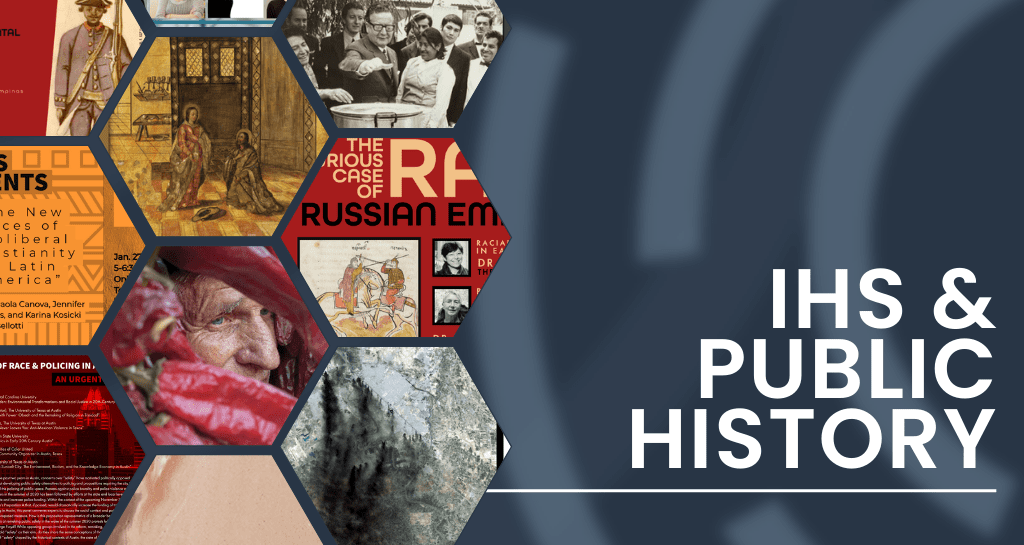
IHS and Public History
- Institute for Historical Studies, Race and Caste Research theme, 2021-22
- IHS Podcast – Faith in Science? COVID, Antivaxxers, the State, and Epistemological Power with guests Sean F. McEnroe, Stephan Palmie, and J. Brent Crosson
- Roundtable: “Faith in Science: From the Boxer Rebellion to Covid 19” feat. Sean F. McEnroe (Southern Oregon University), Stephan Palmie (University of Chicago), J. Brent Crosson (UT Austin), Nancy Rose Hunt (University of Florida), and Jorge Cañizares-Esguerra (UT Austin)
- IHS Podcast – From Republic of Letters and Imagined Communities to Republics of Knowledge: Knowledge in the Making of 19th Century Radical Republics in Latin America with guests Nicola Miller and Alexander Chaparro-Silva
- Republics of Knowledge, Democracy, and Race in Nineteenth-Century Spanish America by Alexander Chaparro-Silva
- IHS Podcast -Apache Diaspora in four hundred years of colonialism vs ‘Toltec Antiquities’ Diaspora in Early Republican Mexico” with guests Miruna Achim, Paul Conrad, and Sheena Cox
- IHS Podcast: Hungry for Revolution with guest Joshua Frens-String
Hungry for Revolution (2021) is an ambitious book that, through the social history of food production, distribution and consumption and through a cultural history of the knowledge and science of nutrition, agriculture, and political economy of rural landholdings, offers a radical new chronology of the political history of 20th century Chile. Hungry for Revolution masterfully goes over the nitrate export boom in the fin-de-siècle mining towns of northern Chile and the creation of the new-deal welfare state of Alessandri and the Frente Popular in the 1930s and 1940s to offer a striking new genealogy of Allende’s Socialist Revolution.
Jorge Cañizares-Esguerra
- IHS Podcast – Colonial Peru’s Fractional Freedoms meet Morgan’s thesis: American Freedom, American Slavery with guests Gary Leo Dunbar and Michelle McKinley
- IHS Book Talk: “Hungry for Revolution: The Politics of Food and the Making of Modern Chile,” by Joshua Frens-String, University of Texas at Austin
- IHS Podcast – Welcomed and then Expelled: The Plight of Chinese Mexicans from 1910 to 1960 with guests Jian Gao and Julia María Schiavone Camacho
- IHS Podcast – The social history of 16th and 17th century Andean “ethnographic” knowledge, bottom-up or top down? with guests Rafael Nieto-Bello and Jose Carlos de la Puente
- IHS Podcast – Mexico’s Social Science Laboratory and the Origins of the US Civil Rights Movement (1930-1950) with guests Rodrigo Salido Moulinié and Ruben Flores
- IHS Panel: “Prop A in the Context of Race and Policing in Austin, Texas: An Urgent Forum”
- IHS Book Talk: “‘Tribe and State in Global History’: The Political and Cultural Work of the Category of Tribe in the Historiographies of Asia, Americas, and Africa,” by Sumit Guha, University of Texas at Austin
- IHS Workshop: “Covarrubias’ Crossings: Picturing the New Negro and the Making of Modern Mexico” by Rodrigo Salido Moulinié, University of Texas at Austin
- IHS Roundtable: ‘The Eyes of Texas’: Historians’ Perspectives on the Origins of the Song
- IHS Podcast – The New Faces of God in Latin America with guest Virginia Garrard
- IHS Podcast – Against the Grain: Textile Relics and the Science of Sanctity in the Global Renaissance with guest Madeline McMahon
For most individuals, the Counter Reformation sought to quash new forms of democratic spiritual participation in the form of Lutheranism and Calvinism. The so-called Galileo affair epitomizes this narrative of the Counter Reformation as retrograde and even villainous. In the popular imagination, Galileo stands as the victim of the Counter Reformation’s stifling prosecution of skepticism, experimentation, and modernity. Yet Dr. Madeline McMahon begs to differ. In her manuscript the Catholic Creation of Early Modern Knowledge, McMahon argues that by creating the institution of the resident (non-absentee) bishop, the Counter Reformation became the lynchpin to the new confessional, interventionist, technocratic early-modern state.
Jorge Cañizares-Esguerra
- IHS Workshop: “Invading Iraq” by Aaron O’Connell, University of Texas at Austin
- Talleres y Debates: “Sobre la destrucción y reconstrucción de imperios, de Hispanoamérica continental a Brasil (1810s-1820s)”
- IHS Podcast – A Time to Gather: Archives and the Control of Jewish Culture with guest Jason Lustig
- IHS Book Roundtable: “A Time To Gather: Archives and the Control of Jewish Culture”
- IHS Book Roundtable: “The New Faces of Neoliberal Christianity in Latin America”
- IHS Podcast – E Pluribus Tria: Colonial Racial Formation in the Making of American Culture with guest James Sidbury
- IHS Roundtable – The 1619 Project: A U.S. Perspective
- IHS Symposium: The Curious Case of Race in the Russian Empire (16-19cc)
- IHS Book Roundtable: What Belongs in Mexico’s National Museum?: Two Centuries of Object Collecting, Display, and Dispersal
- IHS Roundtable: Between Neocolonial Collecting and Anticolonial Resistance? The Logic of Afro-Latiné/Latiné/Latin-American Archives in the United States (Benson Centennial)
- IHS Roundtable: The 1619 Project: A Continental, Afro Latiné Perspective
- IHS Talleres y Debates: “Sobre Talento, Objetos, y Colonias en la Exposición ‘Tornaviaje’ del Museo del Prado”
- IHS Roundtable: The Foremothers of Women of Color Feminism
- IHS Book Roundtable: “Ingredients of Change: The History and Culture of Food in Modern Bulgaria” by Mary Neuburger, University of Texas at Austin
Author Spotlights
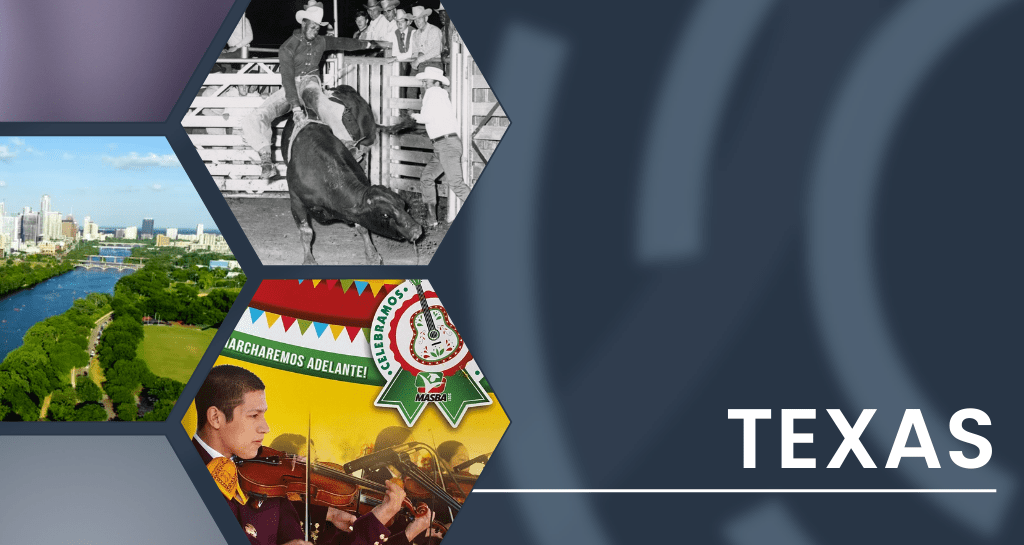
Texas
In our exhibit Black Cowboys: An American Story, visitors from Texas, and beyond will be introduced to a diverse group of African American cowhands, from Johana July, a free Black Seminole born in 1860 to Myrtis Dightman, called “The Jackie Robinson of Rodeo” who broke the color line at professional rodeos in the late 1960s. In addition to presenting the public with depictions of numerous Black cowboys, enslaved and free, the Witte Museum introduces the audience to the legacy of Black ranches and freedom colonies throughout Texas. The audience learns about several Black owned ranches that have stood the test of time, outlasting white supremacy and Jim Crow. These ranching families, who continue to ranch the land purchased and maintained by their ancestors in the nineteenth-century, display a tenacity of will and a commitment to their family traditions. They often withstood destruction of their family legacy by organizations such as the Ku Klux Klan while also weathering continual threats of encroachment from neighbors and state governments.
Ronald Davis




